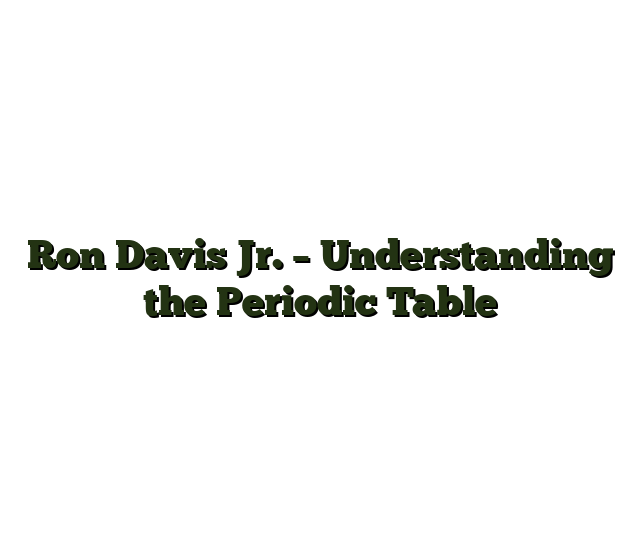Ron Davis Jr. – Understanding the Periodic Table
Ron Davis Jr. – Understanding the Periodic Table course is now available at an affordable price. You can check out directly using multiple payment gateway options. If you have any questions or need an alternative payment method, feel free to contact us.
Ron Davis Jr. – Understanding the Periodic Table
Ron B. Davis Jr., Ph.D.
I hope this contributes to a lifelong journey exploring and appreciating the rich and beautiful chemistry of life and our world.
Institution: Georgetown University
Alma mater: Pennsylvania State University
Course Overview
The basic elements that make up all matter on Earth have existed from the planet’s earliest days, but it wasn’t until the 18th century that debates emerged about the mapping and classification of such elements. After a series of new and exciting discoveries in the bustling field of chemistry—including nitrogen in 1772, followed by oxygen in 1774—a sense of urgency captured the scientific community. What were scientists to make of these “new” elements? And why did they so often struggle to reach consensus in the discovery of these crucial world-building materials? The story of the periodic table of elements is, in some ways, a map of the history of chemistry and scientific classification of matter.
By the late 18th century, the desire to organize and thus better understand our physical world was not a new phenomenon. The ancient Greek philosopher, Aristotle, sought to categorize living beings into two groups—“blooded” and “bloodless”. In the 1730s, the Swedish botanist, Carl Linnaeus, developed a naming system that sorted live organisms into a breadth of categories. What ultimately emerged from 18th-century debates about the classification of elements was a decision to establish a similar set of standards: the qualities, properties, and behaviors of elements.
Published for the first time in the late 1800s, the simple 28-cell table was the brainchild of acclaimed scientist Dmitri Mendeleev. This marked the beginning of a centuries-long revolution in chemistry. Since the first publishing of the periodic table of elements, teams of scientists have competed for the opportunity to add elements to its rows. During their scientific work, they used the table while they determined how to forge stronger metals, create medicines, produce devastating chemical weapons, and discover a range of other life-altering innovations.
While many people have studied and worked with the periodic table in the past—likely in middle or high school—their familiarity is often limited to a surface-level understanding. With a deeper dive, the table becomes a more sophisticated—and, ultimately, more useful—tool. In Understanding the Periodic Table, you will delve into the famous columns and rows that govern the field of chemistry, with Professor Ron B. Davis Jr. of Georgetown University as your expert guide. A science lecturer with over 10 years of teaching experience, Ron is able to distill difficult material into digestible, comprehensive lessons that even novice chemistry students can understand. In 24 detailed lessons that mix lecture-style learning with hands-on experiments and lab demonstrations, you will get the chance to complete your understanding of the periodic table and its 118 elements.
The Periodic Table: A Bird’s-Eye View
The modern table contains clues that can help you deduce the abundance, origins, distribution, and behaviors of 118 unique materials. You’ll find that the elements are grouped not only by their number of protons, but also by their potential reactivity; that valence electrons are key to both the location and identity of elements; and that the history of elements is forever etched into—and can thus be drawn out from—this simple but powerful chart.
A nuanced understanding of one of the most iconic images in modern science equates to a better understanding of the materials and chemical processes that forged our physical world. This comes with practical applications and benefits as well. Better medicines, flying devices, machinery, lights, headphones, automobiles, and even better diets emerge when we are able to discern between elements while harnessing their unique properties.
In Understanding the Periodic Table, you will acquire a holistic understanding of this crucial tool. You will uncover its long, complex, and sometimes fraught history, and explore its classification standards from atomic weight to number of protons to behavior of electrons in the valence shell. You will also discover what sort of data it captures, both by design and by accident. Then, learn about the elements as you take an introductory tour of its groups and subgroups like metal, metalloid, nonmetal, noble gas, halogen, and more. By the end of this course, you will emerge with a more sophisticated view of the table as an instrument of chemistry, map of the history of science, and distillation of our physical world, all at the same time.
From Arsenic to Zinc: The Elements
In Understanding the Periodic Table, you will explore the periodic table’s 118 elements in great detail, from its noble gasses to its transition metals, and much more. As you move from group to group, Ron will shine a light on each element, including aspects such as:
Discovery: How and where an element was first obtained can reveal a great deal about its place on the periodic table and vice versa. Does it exist naturally within the Earth, like iron or copper? Is it a highly reactive element that needs to be isolated in order to reveal its true form, like hydrogen or oxygen? Or does it need to be produced in a lab under highly specific, sometimes dangerous conditions like plutonium? And what were the motivations—personal, political, scientific—behind its discovery?
Atomic Structure: Dmitri Mendeleev determined that elements on the table should be sorted based on their atomic weights, which are closely tied to their atomic structures. Later, scientists would determine that the number of protons actually determines an element’s place on the periodic table. Of course, the number of neutrons and electrons, as well as the behavior of all particles when packed together, also comes into play. Discover how even the smallest changes in an element’s subatomic structure can fundamentally alter its properties, identity, and location on the periodic table.
Behaviors: An element’s reactivity, melting point, natural state, electronegativity, abundance, distribution, and stability are imminently knowable. Its atomic structure is closely tied to its behavior; so, if you know the former, you can accurately predict the latter. You will learn about the chemical behaviors that have created and continue to govern the physical world and you will understand how elements come together, pull apart, explode, liquify, solidify, and everything in between, here on Earth and in the wider cosmos.
Everyday Uses: With a clear sense of what elements look like at the subatomic level and how they behave, you are able to study their real-world, practical applications. How did scientists utilize the final row of elements on the periodic table to create wartime weapons? How can you use rare Earth elements to create better headphones? In what ways did the noble metals change the way automobiles are fueled? Begin to seriously and deeply reflect on the impact that innovations in chemistry have had on contemporary society and your own everyday life.
Understanding the Periodic Table provides a comprehensive overview of the table—complete with theoretical and practical knowledge about the elements—along with its groups and the debates that surrounded its most basic organizing principles. As you better understand the processes that create and transform these elements—and learn more about the particles that make them up and determine their behaviors—you will discover just how crucial they are to our lives and to the history of science in the modern world.
“Ron Davis’ course is a masterpiece in clarity and interesting content. A huge amount of original chemical information is beautifully unified by constant reference to the central icon of chemistry, the periodic table of the elements.”
—Dr. Eric Scerri, UCLA chemist and author of The Periodic Table, Its Story and Its Significance.
24 Lectures
1The Periodic Table: Our Menu of Matter
2From Triads to Tables and the Role of Protons
3How Electrons Shape the Table
4Periodic Trends in Element Properties
5The Origin and Distribution of the Elements
6Elements Break Down: Radiation and Fission
7First-Row Opposites: Hydrogen and Helium
8Sodium, Potassium, and the Alkali Metals
9Magnesium, Calcium, and the Alkaline Earths
10Enormous Variety on the Table’s Right Side
11Noble Gases: The “Lazy” Unreactive Elements
12Halogens: The Most Reactive Nonmetals
13Why Oxygen and Nitrogen Are Irreplaceable
14Complexity of Carbon, Sulfur, and Phosphorus
15Silicon and the Metalloid Diagonal
16Aluminum, Tin, Lead, and Other Weak Metals
17The Table’s Great Divide: Transition Metals
18Colorful and Durable Early Transition Metals
19Magnets and Catalysts of the Middle Transition
20From Coins to Toxins: Copper to Mercury
21Rare-Earth Elements: Surprisingly Abundant
22Nuclear Fuel: Thorium, Uranium, and Plutonium
23Creating the Transplutonic Elements
24Superheavy Atoms and the Transfermium Wars
Delivery Policy
When will I receive my course?
You will receive a link to download/view your course immediately or within 1 to 24 hrs. It may takes few minutes, also few hours but never more than 24 hrs. Due to different time zone reasons.
How is my course delivered?
We deliver courses through Google Drive or Telegram. Once your order is complete, you?ll receive an email with a Google Drive or Telegram channel access link to view/download the course.
In case you submit a wrong email address, please contact us to resend the course to the correct email.
Where can I find my course?
Upon completing your order, a link to download or access the course will be sent to your email. Alternatively, you can find it in the ‘My Account’ download section.
If you do not see it there, please share a screenshot of your order and payment with me on Telegram at @ bossallcourses_bot to ensure prompt assistance. I am highly responsive on Telegram.








Reviews
There are no reviews yet.